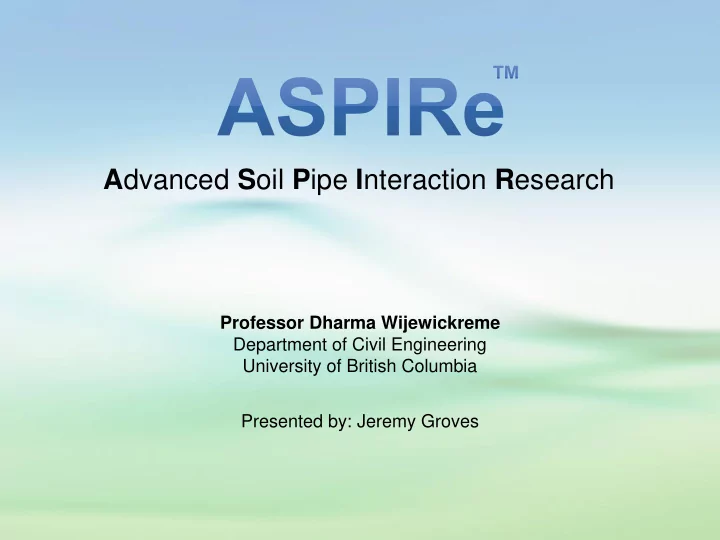

A dvanced S oil P ipe I nteraction R esearch Professor Dharma Wijewickreme Department of Civil Engineering University of British Columbia Presented by: Jeremy Groves
Presentation Agenda • Discuss the need to study soil-pipeline interaction, • Provide an overview of the ASPIRe TM program and testing facility at UBC, • Look at our current research on the topic of field monitoring of buried polyethylene natural gas pipelines subjected to ground movement.
What are pipelines? • Linear structures spanning over long distances, • Variability in soils and groundwater, • Variability of exposure to hazards, • Crossing of environmentally sensitive zones, • Cost effectiveness (e.g. optimize pipe size, material type), • Specific chemical properties of transported liquids/gas. E VER INCREASING DEMAND TO DESIGN AND CONSTRUCT PIPELINES WITH REDUCED RISK OF FAILURE !
Problem for pipeline safety & integrity • Disruption due to landslides, earthquake-induced liquefaction, stress/stretch corrosion cracking and general loss of integrity can have significant impact on performance, • Some quantified risk: • The average costs from significant pipeline damage due to geotechnical incidents over the past 10 years >$400M/year (twice that of damage from other hazards). -US Pipeline and Hazardous Materials Safety Administration • BC’s approx. 40,000 km of pipelines.
Geotechnical hazards to buried pipelines Earth fault movements Rapid landslides Liquefaction-induced ground Slow moving landslides movements
Specific challenges faced by geotechnical engineers • Impact of soil forces on buried pipelines (landslides, earthquake-induced ground movements), • Permanent relative ground deformations are the key concern in relation to the performance of buried pipelines. • Need to minimize soil loads on buried pipelines, • Isolate from hazards, • Tolerate soil loads from the hazards, • Eliminate the hazard. • The key to all of this is to understand the soil-pipeline interaction.
Importance of soil-pipeline interaction • Performance and integrity of pipe under relative movements between pipe and ground (e.g., landslides, earthquakes, pipe thermal movements), • Predict contact pressure around the pipe, loads/strains on the pipe. Wijewickreme et al. (2009)
General problem
One of the key purposes of our research is to help develop guidelines and criteria to determine the amount of ground displacement associated with the safe operational limits of buried pipelines.
Dual actuator-system for lateral pullout
Physical Model Testing at UBC ASPIRe TM
Field monitoring of buried polyethylene natural gas pipelines subjected to ground movement • 12 year long collaboration with Fortis BC pipeline integrity engineers, • Previously two M.A.Sc. and one Ph.D. have studied on this topic, • Developed a new analytical model to account for the soil-pipe interaction mechanisms in buried MDPE pipes, • Used to estimate relative ground surface movements needed for pipe failure. • Purpose of the current work is to provide a reliable database of ground movement and associated pipe strain data to further validate the new closed form solution.
Field monitoring of buried polyethylene natural gas pipelines subjected to ground movement
Field monitoring of buried polyethylene natural gas pipelines subjected to ground movement N
Field monitoring of buried polyethylene natural gas pipelines subjected to ground movement
Field monitoring of buried polyethylene natural gas pipelines subjected to ground movement
Field monitoring of buried polyethylene natural gas pipelines subjected to ground movement Chilliwack slope movements since initial monitoring 0.0900 0.0800 0.0700 101 102 0.0600 Slope movements (meters) 103 104 0.0500 105 106 0.0400 107 108 0.0300 109 110 0.0200 111 112 0.0100 0.0000 0 10 20 30 40 50 60 70 80 Elapsed time (days)
A dvanced S oil P ipe I nteraction R esearch The End
Recommend
More recommend